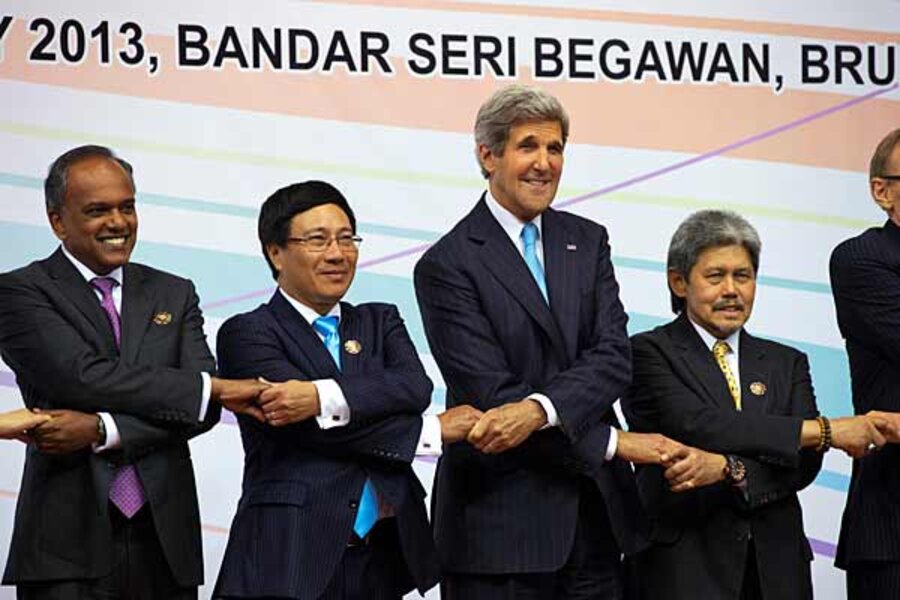Once a divisive pariah, Myanmar could aid Southeast Asian unity
Loading...
| Yangon, Myanmar
Taking their cue in part from regional examples of cooperation such as the European Union, and buoyed by the recent economic opening of Myanmar, the 10 countries that make up the Association of Southeast Asian Nations (ASEAN) plan to form a Southeast Asian economic community by the end of 2015.
An economic community would cut trade costs and make it easier to do business across Southeast Asia – adding to the region's already-burgeoning appeal to outside investors, including companies from the United States.
But, despite the much anticipated opening of Myanmar and flurries of pro-integration rhetoric at events such as the ASEAN foreign ministers meeting in Brunei that US Secretary of State John Kerry attended this week, even a small-scale Southeast Asian version of the EU looks increasingly unlikely to happen by the due date.
In Brunei, disagreements over who is at fault for a throat-clogging haze blanketing parts of Malaysia and Singapore, as well as saber-rattling over the disputed South China Sea, overshadowed economic integration discussions and highlighted the sometimes-fractious nature of relations between ASEAN member-states.
Despite more than four decades of cooperation – ASEAN was set up in 1967 – the region's countries are suspicious of any development that appears to trump national sovereignty, says Professor Jorn Dosch of the CIMB ASEAN Research Institute (CARI), a think tank backed by Malaysia's CIMB Bank. If ASEAN is going to become an economic bloc, member states will have to overcome this reluctance, Prof. Dosch says, given that “any process of regional economic integration, and particularly the far-reaching project of a single market and production base, requires regional institutional and decision-making structures which go beyond the traditional sphere of the national autonomy and sovereignty.”
Another drag on ASEAN integration is the economic chasm between richest – the wealthy city-state Singapore – and poorest – newly-reforming Myanmar: 1:61 measured by GDP per capita, compared with 1:8 in Europe, according to a recent CARI report.
Draw for investors and region
Still, investors are keen for the member group to overcome their differences, with increased focus on the region as long-closed Myanmar has opened for business. According to the US-ASEAN Business Council, a US business-backed lobby group in the region, Southeast Asia as a whole hosts the biggest lump of American investment in Asia and would be the US's fifth biggest trade partner if it was counted as a single economy.
Most Southeast Asian countries have posted strong growth even since the 2008 economic downturn in the West, an upswing that economic integration could prolong. With that in mind, some well-known US companies are pushing hard for an ASEAN economic community, which, if measured as a whole, would create the world's ninth biggest economy.
“We’re excited about the growth and accelerating integration of the ASEAN economies,” says Greg Brown, chairman and CEO of Motorola Solutions, who took part in a recent US-ASEAN Business Council fact-finding trip to Southeast Asia.
Officials from ASEAN visited the US earlier this month, promoting – among other business attractions – the region's jungles and beaches as apt movie settings for Hollywood producers and tourists, according to Thailand's Deputy Commerce Minister Sin Kumpha.
If ASEAN were to succeed in creating a sort-of mini EU by 2015, it would bring about faster, cheaper trade across borders. For investors from outside, setting up shop in one country would mean market access to the entire 600 million-population region. This would, the theory goes, make Southeast Asia more captivating to foreign businesses.
Role of Myanmar
Myanmar – once the subject of many disagreements among ASEAN members – will now be a key driver of the proposed economic community. ASEAN has appointed the country as ASEAN chair for the first time in 2014, the pivotal year before the bloc is supposed to be established.
The US recently removed most of the sanctions against what was a military dictatorship and is looking at granting some of the same trade concessions to Myanmar as it gives to 127 other countries.
The opening up of the US market, along with new curbs put on imports from neighboring Bangladesh means “a good opportunity for the Myanmar garment makers,” says Myint Soe, chairman of the Myanmar Garment Manufacturers Association. It would allow Myanmar’s vital garment sector, which employs around 150,000 people, to regain a foothold in the US market lost during the sanctions era.
And for Myanmar businesses, accessing Western markets likely trumps the benefits that could accrue from freer trade within the Southeast Asia region. Indeed, there are concerns in some of the region's poorer countries such as Myanmar that the economic bloc could benefit bigger, established companies from richer countries such as Singapore, Malaysia, and Thailand – as well as companies from outside – over businesses from the poorer nations.
Therefore, says Mr. Myint Soe, fighting for American buyers and international markets – often against longer-established Cambodia, Indonesia, and Vietnam-based rivals – is seen as vital. “We are hoping to access the American market more,” he says.
While Myanmar will have a crucial role in pushing the economic union plan along, commercial rivalries could still disrupt that role.
Myanmar's keenness to access the US and bite a chunk out of regional competitors' market share is a reminder of the wider region's jostling, sometimes cut-throat commercial realities, which often run against the grain of the proposed economic community. As pointed out by Sanchita Basu Das of the Singapore-based Institute for Southeast Asian Studies (ISEAS), writing in a 2012 scorecard on progress toward the proposed economic community, “ASEAN economies are still more characterized by competition than complementarity.”








